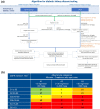The Place and Value of Sodium-Glucose Cotransporter 2 Inhibitors in the Evolving Treatment Paradigm for Type 2 Diabetes Mellitus: A Narrative Review
- PMID: 35307801
- PMCID: PMC8934539
- DOI: 10.1007/s13300-022-01228-w
The Place and Value of Sodium-Glucose Cotransporter 2 Inhibitors in the Evolving Treatment Paradigm for Type 2 Diabetes Mellitus: A Narrative Review
Abstract
Over recent years, the expanding evidence base for sodium-glucose cotransporter-2 inhibitor (SGLT2i) therapies has revealed benefits beyond their glucose-lowering efficacy in the treatment of Type 2 diabetes mellitus (T2DM), resulting in their recognition as cardiorenal medicines. While SGLT2is continue to be recommended among the second-line therapies for the treatment of hyperglycaemia, their true value now extends to the prevention of debilitating and costly cardiovascular and renal events for high-risk individuals, with particular benefit shown in reducing major adverse cardiac events and heart failure (HF) and slowing the progression of chronic kidney disease. However, SGLT2i usage is still suboptimal among groups considered to be at greatest risk of cardiorenal complications. The ongoing coronavirus disease 2019 (COVID-19) pandemic has intensified financial pressures on healthcare systems, which may hamper further investment in newer effective medicines. Emerging evidence indicates that glycaemic control should be prioritised for people with T2DM in the era of COVID-19 and practical advice on the use of T2DM medications during periods of acute illness remains important, particularly for healthcare professionals working in primary care who face multiple competing priorities. This article provides the latest update from the Improving Diabetes Steering Committee, including perspectives on the value of SGLT2is as cost-effective therapies within the T2DM treatment paradigm, with particular focus on the latest published evidence relating to the prevention or slowing of cardiorenal complications. The implications for ongoing and future approaches to diabetes care are considered in the light of the continuing coronavirus pandemic, and relevant aspects of international treatment guidelines are highlighted with practical advice on the appropriate use of SGLT2is in commonly occurring T2DM clinical scenarios. The 'SGLT2i Prescribing Tool for T2DM Management', previously published by the Steering Committee, has been updated to reflect the latest evidence and is provided in the Supplementary Materials to help support clinicians delivering T2DM care.
Keywords: Cardiorenal protection; Cardiovascular disease; Cardiovascular risk; Chronic kidney disease; Diabetic kidney disease; Heart failure; Oral glucose-lowering medicines; Prescribing tools; SGLT2 inhibitors; Type 2 diabetes mellitus.
© 2022. The Author(s).
Figures





References
Publication types
LinkOut - more resources
Full Text Sources
Research Materials
Miscellaneous

